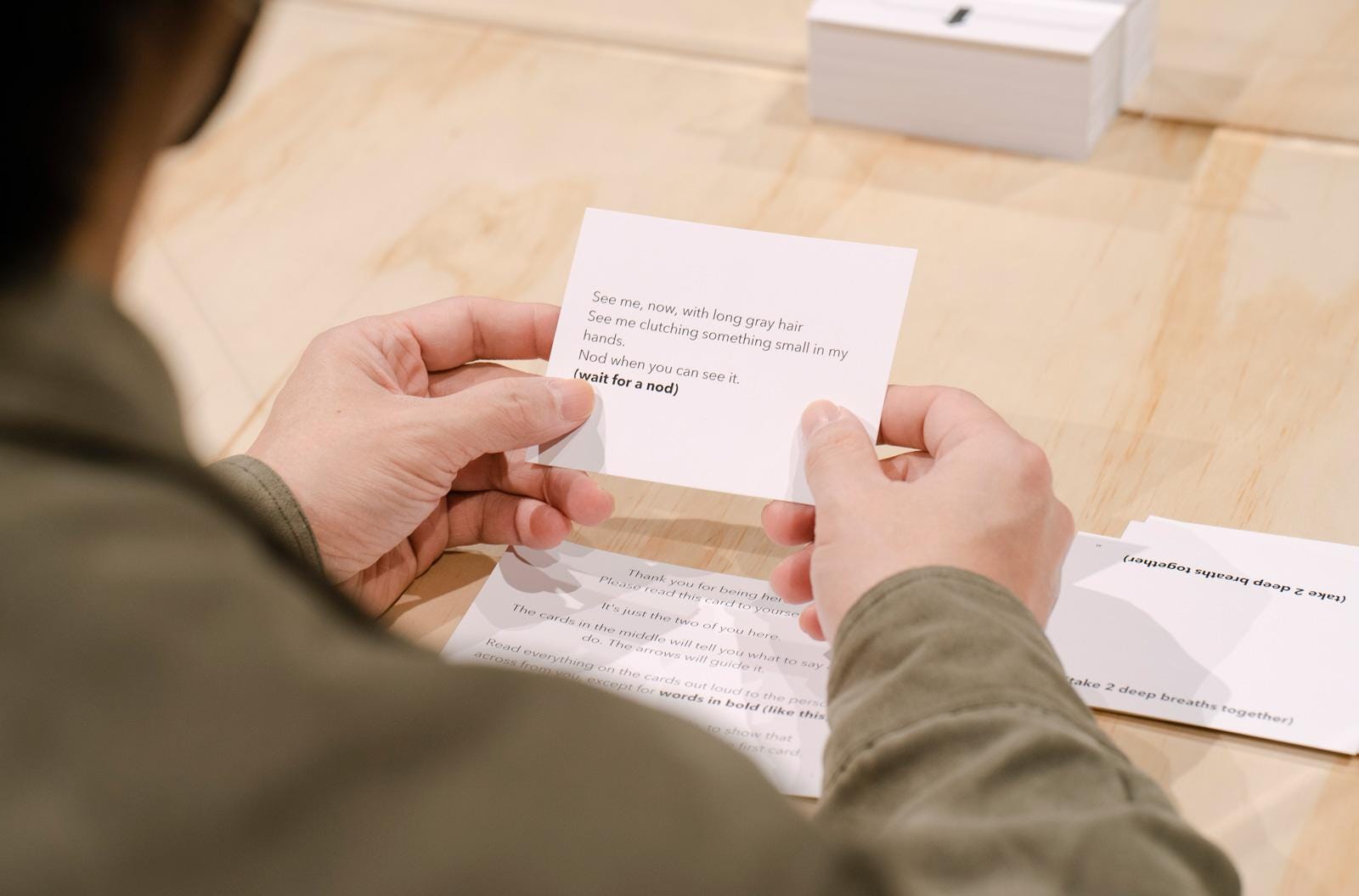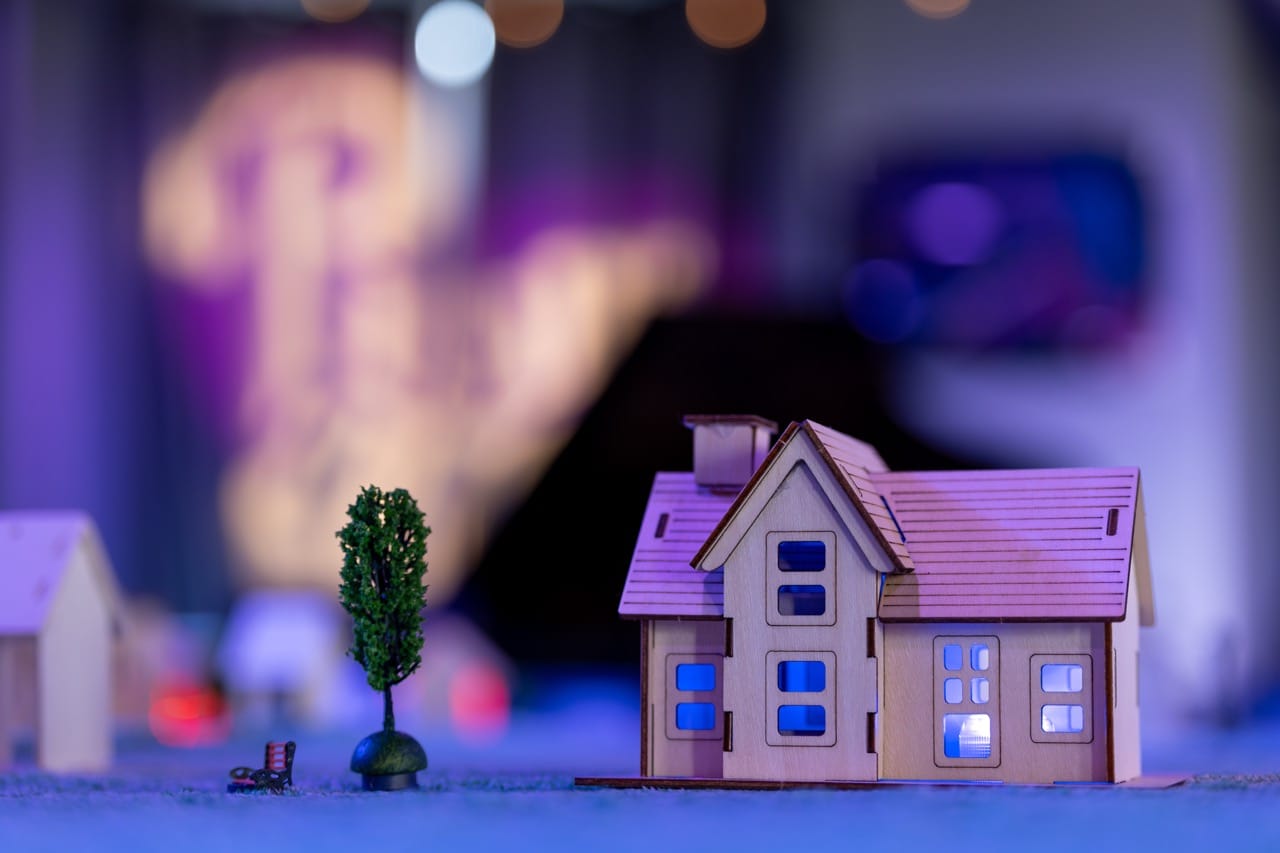
A Thousand Ways, Part Two: An Encounter builds on Part One’s brilliant format, driven by exchanges between two participants. In this case, Part One’s remote, phone-based version is replaced by an in-person volley. Alone in a room, seated at opposing sides of a table and separated by a plane of plexiglass, the other participant and I faced each other, culling paper cards from a central stack. We, two strangers, revealed details of ourselves as instructed by the cards. For almost the entire time our responses were limited to one word, and yet that limitation still allowed for revelation.
(Minor spoilers follow.)
Compared to Part One, Part Two creates a different kind of tension within this new framework. We were layered in barriers: the plexiglass, our face masks, and the cards’ insistence to adhere to particular rules. We were also steeped in intimacy: physical proximity, purposefully breathing together and, at times, conveying entire poems of our lives through eye contact and our monosyllabic, yet expressive responses of “yes” and “no.” Part One harbored space for and even insisted on descriptive reflections; in contrast, Part Two restricts detail. Even though Part Two encourages intimacy through visual layers of gesture and bodily nuance, the verbal constraints are painful, provocative, and freeing.
The entire experience was a fascinating mix of feeling fully present and oddly nostalgic within the same moment. Similar to Part One, the experience toggles between composed narratives printed on the cards and participants’ personal, singular contributions. As active participants, my companion and I read from the cards, hearing the written narratives out loud for the first time; simultaneously, we embodied our prescribed, performative roles by recounting these brief, constructed “memories” to each other. The result was a torqued sense of discovery; a heightened version of déjà vu.
Part Two also upends the definition of “small talk.” Over the course of the production, nothing felt insignificant and now, even after its conclusion, every utterance seems like a vital runway into meaningful stories, coloring in the outline of a complete person. At different points, my companion asked two questions of me, two questions I struggled to answer. “Yes” or “no” felt heartbreakingly inadequate. Both times I bowed my head, low and close to the table’s splintered surface, searching for the answers within myself. I could have made an instinctual choice or flipped a coin in my mind, but the magic of A Thousand Ways is that it’s an inquiry of the self as much as it’s a dialogue with the other person. Part One and Part Two are dual explorations of self and other, and it’s only through others’ revelations that we can harvest space within ourselves to peer at the depths, contradictions, and veracity of our own truths.
Get Laura Hess’s stories in your inbox
Join Medium for free to get updates from this writer.
SubscribeSubscribe
In Part Two, there was one moment where the cards’ instructions allowed my companion to break free from the prescribed scaffolding. He offered a detail about his family: he’s the middle child of five. My internal response was laughingly disproportionate to this information crumb; I felt like I’d won the lottery and as though this was my introduction to the concept of being the middle of five kids. The imparted information seemed like a bounty, a novel treasure to cherish, investigate, and protect.
Every time I nearly breached the show’s directives, I stopped myself. Making that decision for myself was one thing, but making it for my companion felt like a gross transgression of our unspoken agreement — not only our agreement within the show, but our agreement on a fundamental, human level. And yet, the only way for us to huddle around whether or not we wanted to diverge from the rules meant one of us would have to violate the rules before we mutually agreed to violate the rules. I couldn’t do it. I couldn’t do it because even without knowing this person, I cared about them and our impact on each other.
That’s the beauty of A Thousand Ways: the framework anchors participants in vulnerability and empowerment. There’s a visceral, full-body sensation of this specific kind of shared exploration and the empathetic investment it cultivates; there’s a keen awareness of the ripple effect our choices and actions have on others. Once we sit in this awareness and feel its responsibility, time seems to slow and a deeper consideration swells: the care with which we engage others.
Time also shifted in its units of measurement; it was no longer tallied in minutes, but in cards. The diminishing center stack and the disorganized castoffs on either side of the plexi amplified a feeling of urgency — how much would the remaining cards allow me to ask and uncover? — and a dread around the finality. My mind and body rebelled against the production’s restrictions; the more I learned, the more I wanted to know. And the ending only magnified this effect.
My companion, a stranger, likely lives here in Los Angeles. Will we meet again? Could we find each other someday? Would we even recognize each other since the masks covered most of our faces? And while that possibility is wondrous, I realize it’s not necessary. In Part One, an automated guide for the two participants repeatedly states, “Words are all we have. Words are not enough.” I left Part Two full of longing, sadness, and real joy. There weren’t enough words and there wasn’t enough time. None of it felt like enough — which was perfect.
A Thousand Ways Part Two: An Encounter by 600 Highwaymen plays through June 20th at the La Jolla Playhouse in La Jolla, CA.
Discover the latest immersive events, festivals, workshops, and more at our new site EVERYTHING IMMERSIVE, new home of NoPro’s show listings.
NoPro is a labor of love made possible by our generous Patreon backers. Join them today!
In addition to the No Proscenium website, our podcast, and our newsletters, you can find NoPro on Twitter, Facebook, YouTube, Instagram, in the Facebook community Everything Immersive, and on our Discord.















Discussion